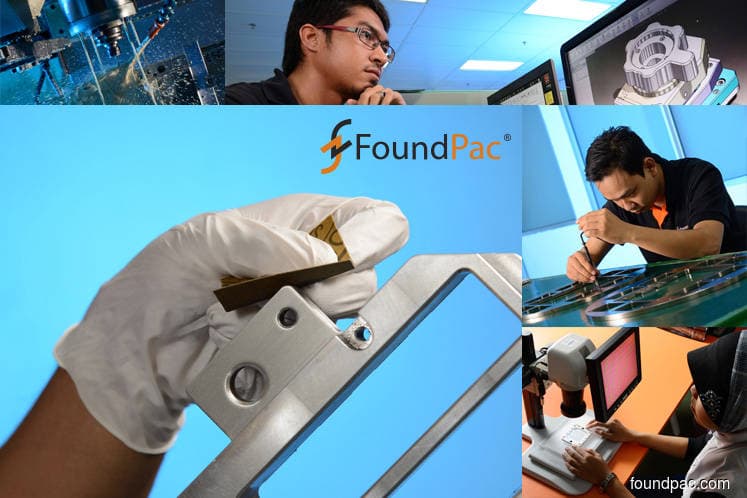
This article first appeared in The Edge Malaysia Weekly on August 7, 2017 - August 13, 2017
PENANG-based FoundPac Group Bhd, which had a rather disappointing financial year ending June 30, 2017 (FY2017), hopes to recover lost ground in FY2018. The group’s revenue is expected to decline at a double-digit rate in FY2017 before it rebounds, according to chief financial officer Ong Choon Heng.
“We should see double-digit growth in revenue for FY2018 and our profits will increase consequently,” he tells The Edge in an interview.
For the nine months to March 31, 2017 (9MFY2017), FoundPac recorded a net profit of RM7.4 million on revenue of RM25.5 million. Exports remained the main contributor, accounting for RM24.08 million or 94.43% of total revenue for the group, which designs and manufactures stiffeners and high-performance test sockets.
Ong acknowledges that FoundPac’s full-year performance for FY2017 is unlikely to match FY2016’s net profit of RM16.4 million and revenue of RM44.1 million as sales in 1HFY2017 were impacted by slower orders from its single largest customer— US semiconductor giant Broadcom Ltd.
“Following the merger with Avago (Technologies), our major client Broadcom slowed down its purchasing activities, and hence, our sales fell on lower demand,” he says.
Broadcom is the merged entity from the February 2016 acquisition of California-based wireless chipmaker Broadcom Corp by Singaporean chipmaker Avago Technologies Ltd.
Fortunately, things are getting better and FoundPac is now aiming to restore its revenue and profitability to the levels achieved in FY2016.
“As the merger exercise is over, Broadcom has now returned and its orders have started to pick up again. In the meantime, we have also secured some new customers,” Ong says.
“We still managed to maintain our gross profit margin at more than 40%. Hopefully, our numbers in FY2018 can match those of FY2016.”
FoundPac was listed on the Main Market of Bursa Malaysia in December last year. The stiffeners and high-performance test sockets it makes are mainly used by multinational semiconductor corporations, including fabless semiconductor firms, printed circuit board (PCB) design houses, as well as companies in the outsourced semiconductor assembly and test (OSAT) industry.
FoundPac is involved in the front-end and back-end of semiconductor testing, namely wafer testing and final integrated circuit (IC) testing, which are both considered electrical functional tests, notes Low Cher Shyong, vice-president of sales and marketing at Found Technologies Sdn Bhd, a wholly owned subsidiary of the group.
“The entire semiconductor process starts from wafer fabrication, which we are not involved in. After wafer fabrication is completed, you need to test the wafer, and that is where FoundPac comes into the picture. We are involved in the testing process, not the assembly process,” he explains.
In the semiconductor testing process, he adds, OSAT companies need equipment to test the IC, sometimes called a chip. For the tester to “communicate” with the IC, an interface comprising a PCB or test board is required.
“But for the test board to dock inside the tester, you need a mechanical fixture to align the test board to the tester. Our stiffener is that mechanical fixture. Meanwhile, for the test board to ‘communicate’ with the IC, we need another interface — the test socket, which holds the IC and ‘talks’ to the test board,” Ong says.
In a nutshell, two interfaces are required in the IC test — one between the test board and tester (using stiffener to hold the test board), and another between test board and the IC (using a test socket to hold the IC).
Stiffeners currently make up 70% of FoundPac’s revenue, with the remainder comprising test sockets.
The group sells stiffeners at US$1,200 per piece on average while the price for test sockets can range from US$2,000 to US$25,000 each.
FoundPac CEO Lee Chun Wah says there is no seasonal factor in its business as the group works closely with research and development experts at the front-end of the value chain, and is not involved in the end products.
“We are always busy because R&D activities never stop. When there is a crisis, R&D will be even more active. When there is no crisis, our customers need to create more new products.” He says FoundPac has 102 active customers, which have been giving it orders in the past 12 months.
“When our customers have new PCBs and ICs, the common practice is that they will not reuse old stiffeners. That’s because the process of dismantling, then retesting and reusing an old stiffener probably costs more than buying a new one.
“The risk of reusing old stiffeners is very high because a new PCB is very expensive. You don’t want to reuse something cheap and damage something new and expensive,” Lee notes.
FoundPac’s closest competitor is homegrown high-performance test contacting solutions provider JF Technology Bhd.
Lee, however, is of the view that FoundPac and JF Technology are not direct competitors as the they are in different market segments.
“There are many types of IC packaging in the market. JF Technology only focuses on certain types, whereas our range of customers is bigger. So far, we have not bumped into each other,” he says.
Year to date, FoundPac shares have risen 34% to close at 90 sen last Thursday, giving it a market capitalisation of RM333 million. The counter is trading at a trailing 12-month price-earnings ratio of 17 times, significantly lower than JF Technology’s 62 times.
Save by subscribing to us for your print and/or digital copy.
P/S: The Edge is also available on Apple's AppStore and Androids' Google Play.